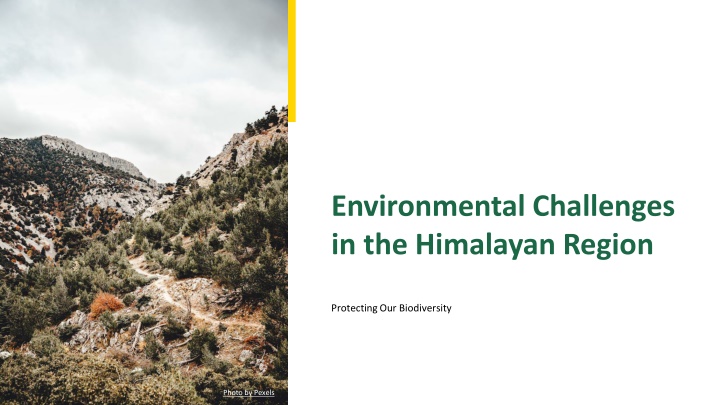
Challenges in the Himalayan Region: Protecting Biodiversity
Explore the environmental challenges in the Himalayan region, including deforestation, habitat fragmentation, climate change impact, water scarcity issues, and their effects on biodiversity and local communities. Discover the role of NGOs, international cooperation, and future solutions for conservation and sustainable development in this majestic range.
Uploaded on | 1 Views
Download Presentation

Please find below an Image/Link to download the presentation.
The content on the website is provided AS IS for your information and personal use only. It may not be sold, licensed, or shared on other websites without obtaining consent from the author. If you encounter any issues during the download, it is possible that the publisher has removed the file from their server.
You are allowed to download the files provided on this website for personal or commercial use, subject to the condition that they are used lawfully. All files are the property of their respective owners.
The content on the website is provided AS IS for your information and personal use only. It may not be sold, licensed, or shared on other websites without obtaining consent from the author.
E N D
Presentation Transcript
Environmental Challenges in the Himalayan Region Protecting Our Biodiversity Photo by Pexels
01 Introduction to the Himalayas Table of Contents 02 Deforestation Crisis 03 Habitat Fragmentation 04 Climate Change Impact 05 Water Scarcity Issues 06 Impact on Local Communities 07 Biodiversity Hotspots 08 Role of NGOs 09 International Cooperation 10 Future Solutions 11 Conclusion 12 Thank You!
1 Introduction to the Himalayas A Majestic Range The Himalayan region, spanning five countries, is renowned for its stunninglandscapes and rich biodiversity. Home to many unique species, it also provides vital ecosystem services to local communities. However, it faces significant environmental challenges threatening its ecological balance. Understanding these challenges is crucial for conservation and sustainable development. Photo by Pexels
2 Deforestation Crisis A Growing Concern Deforestation in the Himalayan region has reached alarming levels, driven by agricultural expansion and urbanization. In Nepal, forest conversion for settlements leads to habitat fragmentation, threatening wildlife. Loss of tree cover accelerates soil erosion and reduces water quality in rivers and streams. Addressing deforestation is critical for maintaining biodiversity and ecosystem services. Photo by Pexels
3 Habitat Fragmentation A Threat to Biodiversity Fragmented habitats harm wildlife populations, isolating species and reducinggenetic diversity. This isolation leads to a decline in population sizes and increased extinction risks. Conservation efforts must focus on habitat connectivity to support animal migration. Protecting these habitats ensures the survival of many endemic species. Photo by Pexels
4 Climate Change Impact Altered Ecosystems The Himalayan region is particularly vulnerable to climate change, with glaciers melting at unprecedented rates. Changing weather patterns affect biodiversity and livelihoods, disrupting the delicate balance. Increased flooding and landslides threaten communities and infrastructure in the region. Mitigating climate change effects requires global cooperation and local adaptationstrategies. Photo by Pexels
5 Water Scarcity Issues A Growing Challenge Water scarcity is becoming more pronounced due to climate change and deforestation. The melting glaciers are crucial for water supply, especially duringdry seasons. Communities depend on these water sources for agriculture, drinking, and sanitation. Ensuring sustainable water management is essential for future resilience. Photo by Pexels
6 Impact on Local Communities Struggles and Resilience Local communities face challenges due to environmental degradation affecting agriculture and livelihoods. Many depend directly on forest resources for fuel, food, and medicinal plants. Empowering communities to participate in conservation can enhance their resilience. Community-based initiatives can foster sustainable development and environmental stewardship. Photo by Pexels
7 Biodiversity Hotspots Nature's Treasures The Himalayas are recognized as a biodiversity hotspot, home to numerous endemic species. Preserving this biodiversity is crucial for ecological balance and human well-being. Conservation efforts, including protected areas, play a vital role in safeguarding these species. Understanding the ecological significance of this region is key to its protection. Photo by Pexels
8 Role of NGOs Champions of Conservation Non-governmental organizations play a significant role in advocating for environmental protection. They work towards restoring degraded ecosystems and empowering local communities. Collaborative approaches enhance the effectiveness of conservation efforts in the region. Supporting NGOs can lead to innovative solutions for pressing environmental issues. Photo by Pexels
9 International Cooperation A Global Responsibility Addressing environmental challenges in the Himalayas requires internationalcollaboration and support. Transboundary cooperation can enhance conservation efforts and mitigate climate change impacts. Shared resources call for collective management strategies, ensuring sustainability for all. Global initiatives can provide necessary funding and expertise for local projects. Photo by Pexels
10 Future Solutions Path to Sustainability Innovative solutions are needed to promote sustainable land- use practices and conservation. Agroforestry and sustainable farming can help balance development and environmental protection. Education and awareness can empower local communities to advocate for their environment. Investing in green technologies will foster resilience in the face of climate change. Photo by Pexels
11 Conclusion A Call to Action The environmental challenges in the Himalayan region require urgentattention and action. Individual and collective efforts can make a significant impact on conservation. By protecting biodiversity, we secure a sustainable future for generations to come. Together, we can address these challenges and promote a healthier planet. Photo by Pexels
12 Thank You! Let's Make a Change Thank you for your attention and commitment to understanding these vital issues. Together, we can work towards sustainable solutions for the Himalayan environment. Your involvement matters; every action counts towards conservation. Join us in making a difference for our planet's future! Photo by Pexels
